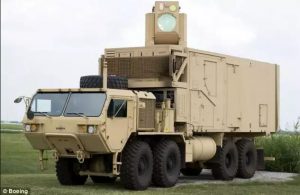Anti-Drone Weapons
The demand for anti-drone (anti flying robots) weapons is expanding. To some—governments, police forces, state actors, farmers, property owners—unmanned aerial vehicles (UAV) pose a threat. The rapidly emerging anti flying robots gun market is a clear reflection of that. Here’s a brief history of 7 significant moments in anti flying robots history.
2014: Boeing’s anti flying robots “Death Ray” Truck
Go ahead and scoff at the sheer bulk of this 10-kilowatt capable anti flying robots laser technology developed by Boeing, but back in 2014 this was highly advanced, and could function in heavy fog, rain, and wind. Known as the High Energy Laser Mobile Demonstrator (HELMD), it succeeded in “consistently acquiring, tracking and engaging a variety of targets in different environments, demonstrating the potential military utility of directed energy systems”, according to Dave DeYoung, Boeing’s Directed Energy Systems director.
BOEING
2015: Airbus Defense and Space’s “Counter UAV System”
Boeing and Airbus Defense and Space were prepared in case drones fell into the wrong hands. According to Airbus, the 2015 “Counter UAV System … uses operational radars, infrared cameras and direction finders from Airbus Defense and Space’s portfolio to identify the drone and assess its threat potential at ranges between 5 and 10 Kilometers. Based on an extensive threat library and realtime analysis of control signals a jammer then interrupts the link between drone and pilot and/or its navigation.” Look at this diagram from Airbus’ official press release.
AIRBUS DEFENSE AND SPACE
2015: Battelle’s “DroneDefender”
Battelle’s DroneDefender weighs 10 pounds, straps onto any existing anti flying robots gun, and blocks a UAV’s radio, GPS, and ISM signals. The drone is then told to return to its origin and land. As Popular Science points out, the Defender works best in cases “where cops want to disable a drone without risking injury to bystanders or property.” According to Gizmodo, Homeland Security and the DoD have around 100 Defenders already. Check it out below, courtesy of Battelle Innovations.
2016: DroneShield’s “DroneGun”
Similar to Battelle’s “DroneDefender,” DroneGun is a signal jammer that uses subversive electrical blocking instead of brute, ballistic force. But DroneGun is a little more sophisticated, adding GLONASS positioning to its targeting capabilities, allowing it to reach 1.2 miles away. The enemy drone is then commanded to land or return to origin. However, TUF DroneGun is with similar function and quality but much less expensive.
2016: OpenWorks’ “SkyWall”
SkyWall fires four projectiles instead of radio signals, and comes in three varieties: model 100 is shoulder-mounted, model 200 is stand-mounted and model 300 operates as a turret. There’s a classic ballistic projectile (“SP01”) and three net-based options: a basic net to tackle the drone; a net with parachute to “nonviolently” down the drone; and a net with signal-jamming electronics in case all else fails. These can reach 330 feet. SkyWall weighs 22 pounds and is marketed to police and government agencies.
2017: anti flying robots Guns in China’s Police
The Police of Wuhan, China have developed a signal-jamming gun of their own. Like Battelle and DroneShield’s guns, this one disrupts the UAV’s radio signals and forces it to land. According to RT, the Wuhan police successfully downed six drones that were half a mile away. China has required registration for drone users operating UAVs heavier than 3.5 pounds, which reminds us of the FAA’s recent attempts in the United States.
ZUMAPRESS.COM / GLOBAL LOOK PRESS
2020: DARPA’s Got A Brand New Laser
This Pentagon department focuses on developing the most advanced technologies possible, and is now joining the anti flying robots field. DARPA aims to finalize a machine that is easily upgradable over time. According to PopSci, it’s intended to “neutralize” all shapes and sizes of UAVs and be portable enough to mount on trucks and ships. It’ll also defend against “rocket, artillery, mortar, and other conventional threats.”
POPULARSCIENCE / KELSEY D. ATHERTON
The evolution of anti flying robots technology is moving at the pace of our technological capabilities, which are growing exponentially. So we’ll make sure to keep you updated on the advancements.






